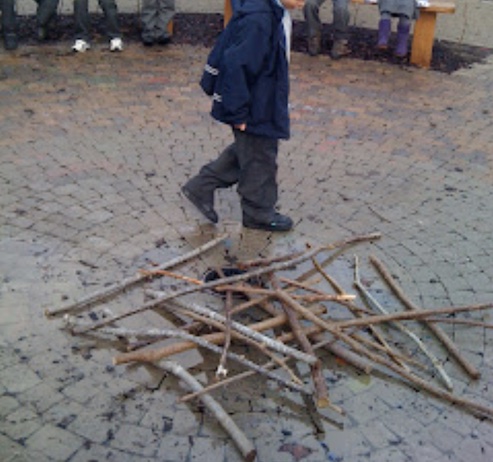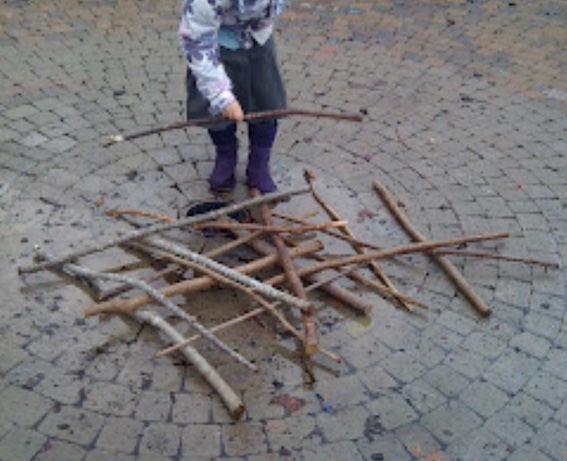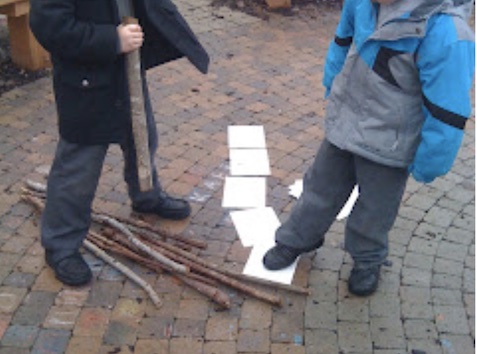Sticks are not a commonly used resource in most schools. Images of children getting hurt through being poked in the eye run rife through the heads of many teachers. The thought of having to confiscate sticks and deal with behaviour issues around mock gun fights and play fights with sticks becoming light sabers puts many teachers off using them. And there’s the splinters, and the broken sharp bits and, and, and…
…and there’s wonderful quote from Richard Bach’s Illusions which states:
“Argue for your limitations and sure enough they are yours.”
The only way to overcome fear and paranoia around sticks is to use them. So today I picked up my bundle of sticks and went into a Primary 1 class whose project is all about toys.
Sticks are wonderful
They are open-ended with a multitude of uses. Before we had even left the classroom, the children had already come up with many ideas from trying sticks out as boomerangs (can we make a stick come back to us?) and using it for fighting and fishing.
They had also decided upon some rules around using sticks “No waving them about” and “No fighting with them.” They also agreed that running in the area with a stick was not a good idea as it is a small outdoor space and that they would not stand or walk on the slippy snow with their sticks. But poking or prodding the snow is a Good and Interesting Thing to Do.
I showed them ways to carry the stick (just use it like a walking stick) and to check for sharp bits and to hold the stick where it feels smooth and comfortable. I stated my one absolute rule and that was that if anyone was using a stick in a silly or dangerous way, it would be removed and they would have to wait until the next day to have another go. There was no second chances or returned sticks even after saying “Sorry.”
We began by making a pile of sticks in the centre of the circle. The children played “Pick up Sticks”, taking it in turns to try and take away a stick without moving any other stick…

This required a little bit of thought…
Some children tried removing sticks from underneath others. Others went for a stick closer to the top…

It felt really exciting to remove a stick and be allowed to keep it…

After this we did a little stick celebration. We thumped our sticks on the ground saying “Well done, everyone.” and then we raised our sticks high above our heads and shouted “Hooray!”
Then the children were challenged to make up a game of their own using sticks…
This pair of children made up their own chant which included a Morris Dancing style of hitting sticks before dropping them on the floor…
Then they decided to colour their sticks with chalk…

On a wet day, they discovered this was quite a messy thing to do…
This pair of boys got really into number games. The white cards have numbers written on them. They thought it would be fun to estimate the number of sticks in different sized bundles and find the right number card to match. The game got increasingly complex with all sorts of rules and forfeits.

When I’m asked about sticks, if educators are concerned, I suggest they begin with dead plant stalks from Rosebay Willowherb or a similar plant that leaves its stem standing through winter. These break on contact with anything so it’s extremely difficult to have a good fight. Plant stalks make great nesting material in dens, etc.
I also suggest trying small sticks first of all and building up to bigger ones. In this lesson I did give the children big sticks and thick, heavy sticks because I knew that the level of supervision was high. Having a variety of lengths and weights adds interests as the children swap sticks around. Music and rhythm work leads nicely into free play with sticks too.
Another springboard into stick use is to read children stories about sticks. My favourite is Stick Man by Julia Donaldson. Recently I discovered Not a Stick by Antoinette Portis which gives children lots of ideas for imaginative play (and adults too)!
At the end of the session, the children rated the activity very highly and felt they had been really sensible with the sticks. They were right. I’ve left the sticks with the class to use again!






























Australian author Gwynneth Beasley writes beautiful children’s book about her own childrens’ experiences in nature and sticks feature quite prominetly in her work. I have all of her books and highly recommend them. I think you would really enjoy them too!
http://www.amazon.com/Zeke-Wooden-Wands-Gwynneth-Beasley/dp/1451534205/ref=ntt_at_ep_dpi_3
Donna 🙂 🙂
We will most definitely be playing pick up sticks sometime soon. Thanks for all the great ideas!
The pickup sticks is a great idea – we have the small version which my eldest son (5 y.o.) loves.
The other common activity with sticks here lately seems to be poking them in the ground to make fence-like structures.
I seem to spend my life navigating the sticks by the front door collected by three year old on walks. Ones longer than his for arm are not allowed in the house. Excitidly this morning announced “Im so glad it is windy” when asked why replied “more sticks will be blown down for me to collect the streets were running out” Sticks are such a wonderful resource simply for sensory properties, length and hight vocab, and creatively through building structures or used for imaginative purposes e.g. walking stick, sword, fishing rod, ore… With supportive adults and carful chats about safety they are essential childhood resource
We teach at a Montessori school in Greensboro, and are very lucky to have a small forest that we play in regularly. Sticks are everywhere, and have become shelters, flagpoles, walking sticks, bridges, shovels, writing utensils, hearths for “houses,” drumsticks, cars, planes, items to paint, spoons for stirring “stew,” counting sticks, and a lot of things the kids will remind me about on Monday.
Have fun, and we are so happy you have put sticks back in their lives!
Fun!! We love to play with chalk on drizzly days : )